The mysterious synchronicity between celestial bodies and Earth’s wildlife has fascinated scientists for generations. Among these cosmic connections, the relationship between moon phases and bird migration stands out as particularly compelling. Birds, those masters of long-distance travel, don’t simply rely on internal compasses and daylight cues—the moon plays a significant role in their epic journeys across continents and oceans. From influencing flight patterns to affecting navigation decisions, lunar cycles create a complex backdrop against which millions of birds stage their seasonal movements. This celestial dance between Earth’s feathered travelers and our nearest cosmic neighbor reveals fascinating adaptations and behaviors that highlight the interconnectedness of our natural world.
The Lunar Calendar and Migration Timing
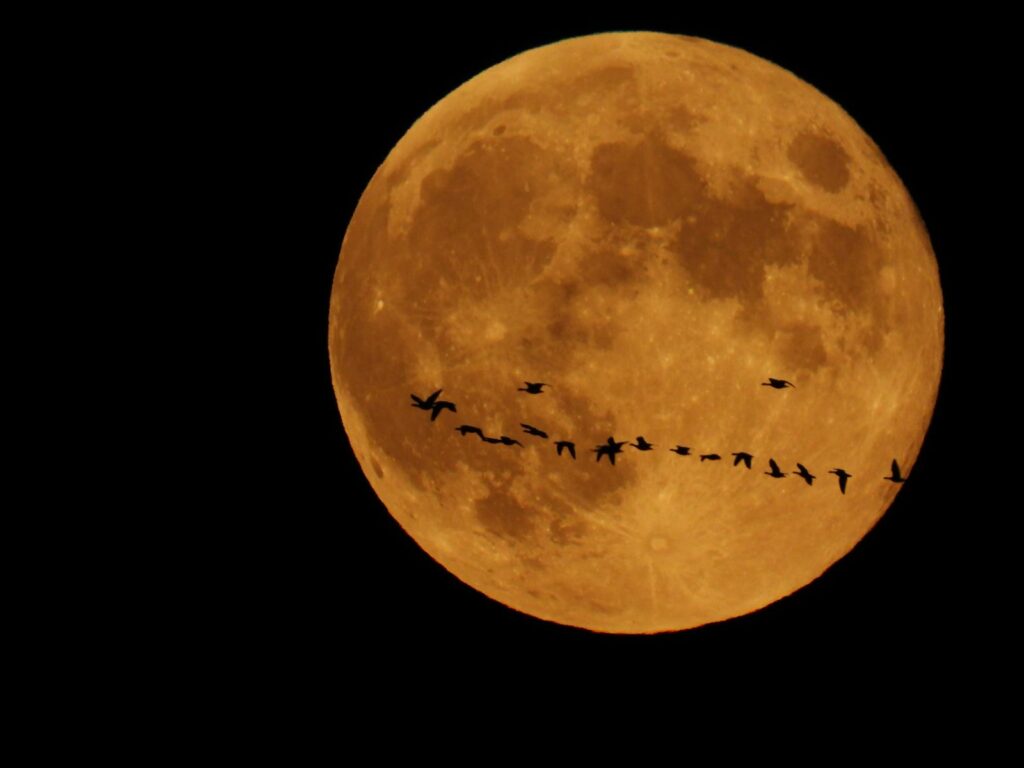
Many bird species time their migrations to coincide with specific moon phases, suggesting an evolutionary adaptation that maximizes survival during these dangerous journeys. Research has found that certain songbird species prefer to begin their migratory flights during particular lunar periods, with the full moon and the days immediately following it showing peak departure numbers. This preference isn’t random—brighter nights provide extended visibility for navigation and predator detection, allowing birds to maintain their bearings while conserving energy. For example, studies on European robins have demonstrated that individuals delay migration when moon illumination is poor, preferring to wait for brighter nights before embarking on challenging cross-continental flights. This synchronization with lunar cycles represents a remarkable evolutionary strategy that balances the urgent need to reach breeding or wintering grounds with the practical realities of navigating through unfamiliar terrain.
Full Moon: Nature’s Migration Spotlight
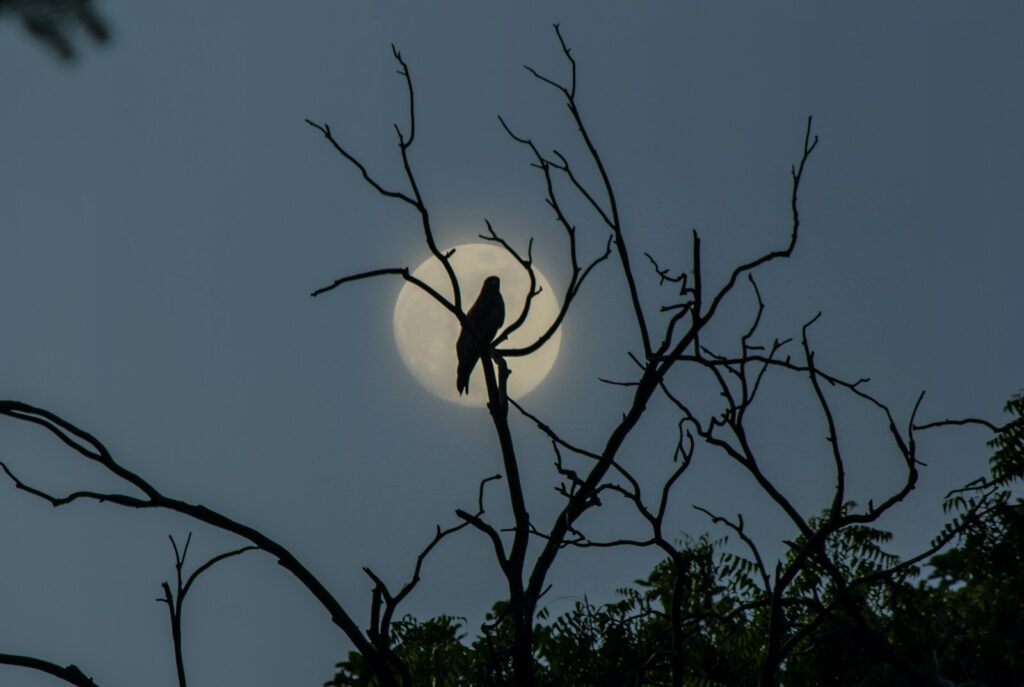
The full moon creates a naturally illuminated landscape that many migratory birds capitalize on during their journeys. When moonlight bathes the earth in its silver glow, birds gain critical visibility advantages that help them identify landmarks, avoid obstacles, and maintain cohesive flock formations. For water birds crossing oceanic expanses, the full moon’s reflection creates a shimmering pathway that aids in maintaining proper orientation when other navigation cues are limited. European studies have documented significantly higher migration activity on clear, full-moon nights among species like thrushes and warblers, with radar tracking showing up to 300% more birds in flight compared to moonless nights. This relationship is so pronounced that ornithologists can often predict migration intensity by referencing the lunar calendar, particularly for species that predominantly travel at night.
New Moon: The Stealth Migration Phase
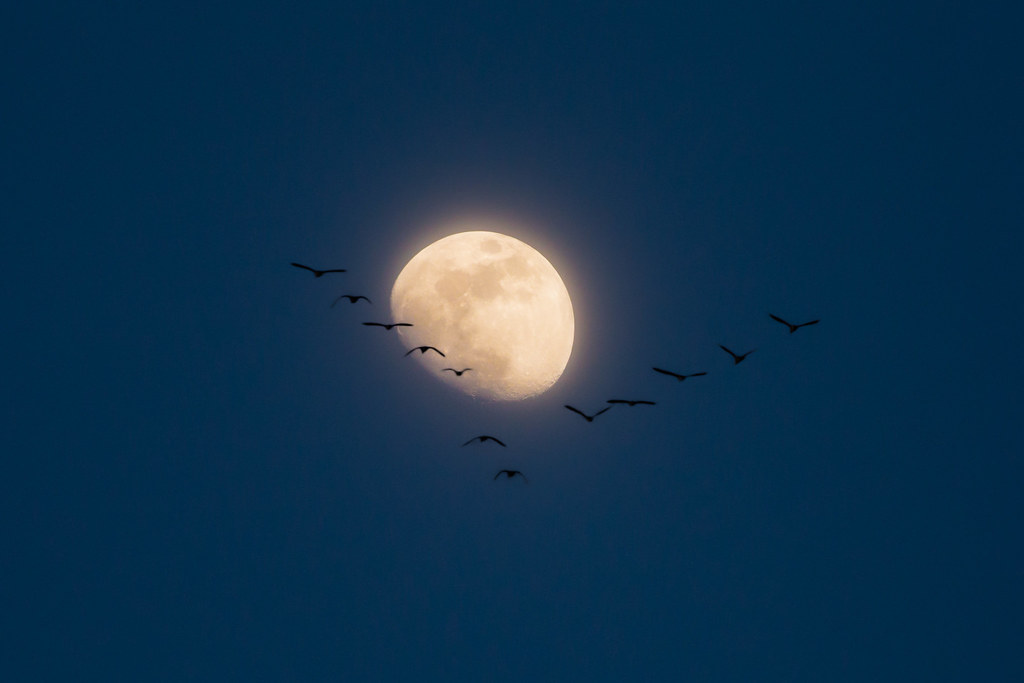
While many birds prefer the illumination of full moons, some species have evolved to take advantage of the darkness provided by new moons. The absence of moonlight creates conditions of near-total darkness that offer certain migratory birds protection from predators that hunt visually. Small songbirds particularly vulnerable to raptors often show increased migration activity during new moon phases, using the cover of darkness as a survival strategy. Researchers studying radar data have observed that species like the Blackpoll Warbler, which undertakes one of the most impressive non-stop flights across the Atlantic Ocean, shows statistical preferences for departing during darker lunar phases. For these birds, the energy cost of navigating in darkness is outweighed by the reduced predation risk, demonstrating how different species have evolved varying responses to the same cosmic cycle.
Lunar Light Pollution and Migration Disruption
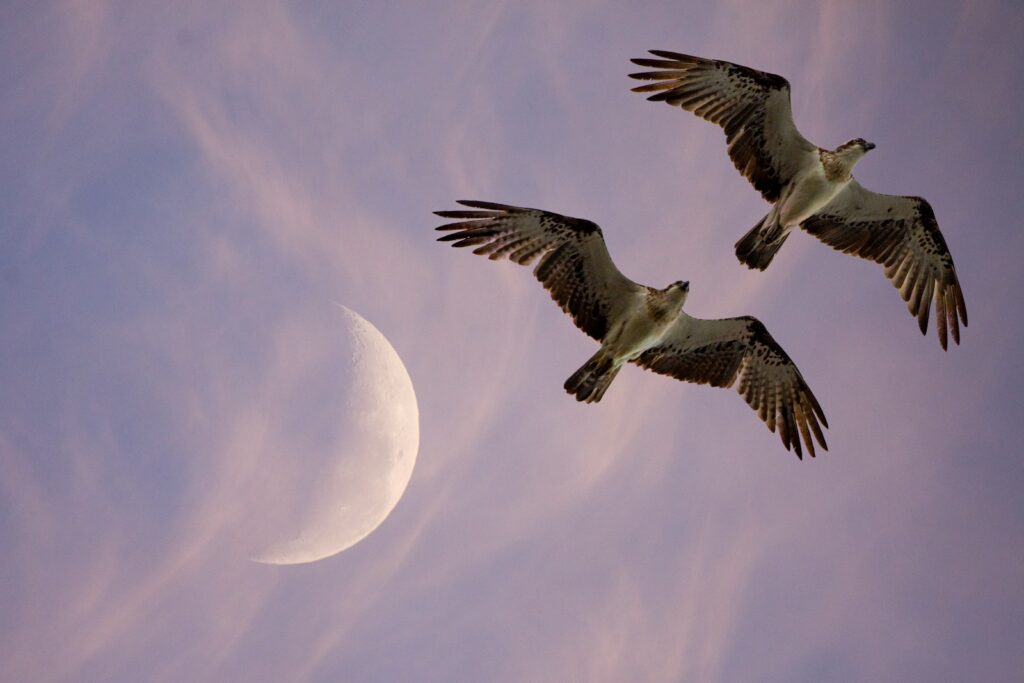
The moon’s natural influence on bird migration faces modern complications from artificial light sources that disrupt the lunar navigation system birds have evolved with. When cities cast their glow into the night sky, they create a competing light source that can overwhelm or confuse birds’ lunar-dependent navigation cues. Research has documented how birds following moon-based migration paths can become disoriented when flying over brightly lit urban areas, sometimes resulting in fatal collisions with buildings or exhaustion from circling illuminated structures. This phenomenon, known as light pollution, has grown increasingly problematic as urban development expands, creating what scientists call “ecological traps” that lure birds away from safe migration routes. Studies comparing historical migration patterns with contemporary data show significant shifts in bird behavior near major metropolitan areas, with some species altering flight paths by several kilometers to avoid the most intensely lit regions.
Lunar Gravity and Migration Energy Dynamics
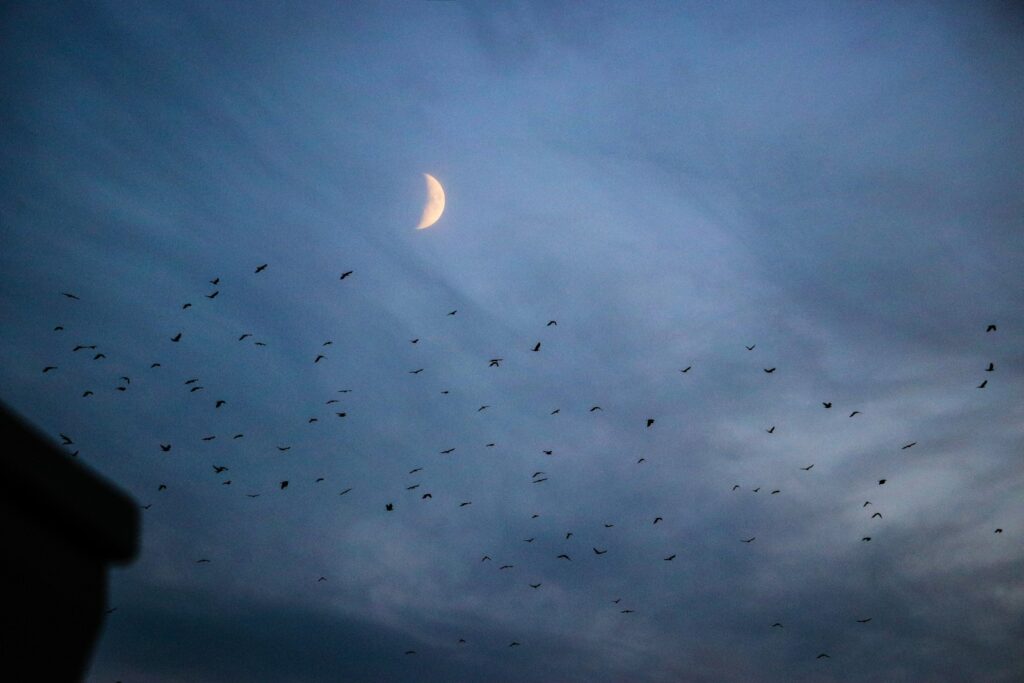
Beyond illumination, the moon exerts gravitational forces that subtly influence Earth’s atmosphere, potentially creating more favorable flying conditions during certain lunar phases. As the moon orbits Earth, its gravitational pull affects air pressure patterns and can generate advantageous tailwinds that migratory birds have evolved to exploit. Ornithologists have observed correlations between lunar phases and atmospheric conditions that suggest birds may time their migrations to coincide with these gravitationally-induced weather patterns. For instance, studies tracking bar-tailed godwits during their remarkable non-stop Pacific flights found that departures often clustered around specific lunar phases associated with favorable high-altitude wind patterns. Though these connections remain partly theoretical, mounting evidence indicates that birds’ evolutionary programming includes sensitivity to gravitational cues that help optimize their energy expenditure during migration.
Circadian Rhythms and Lunar Influences
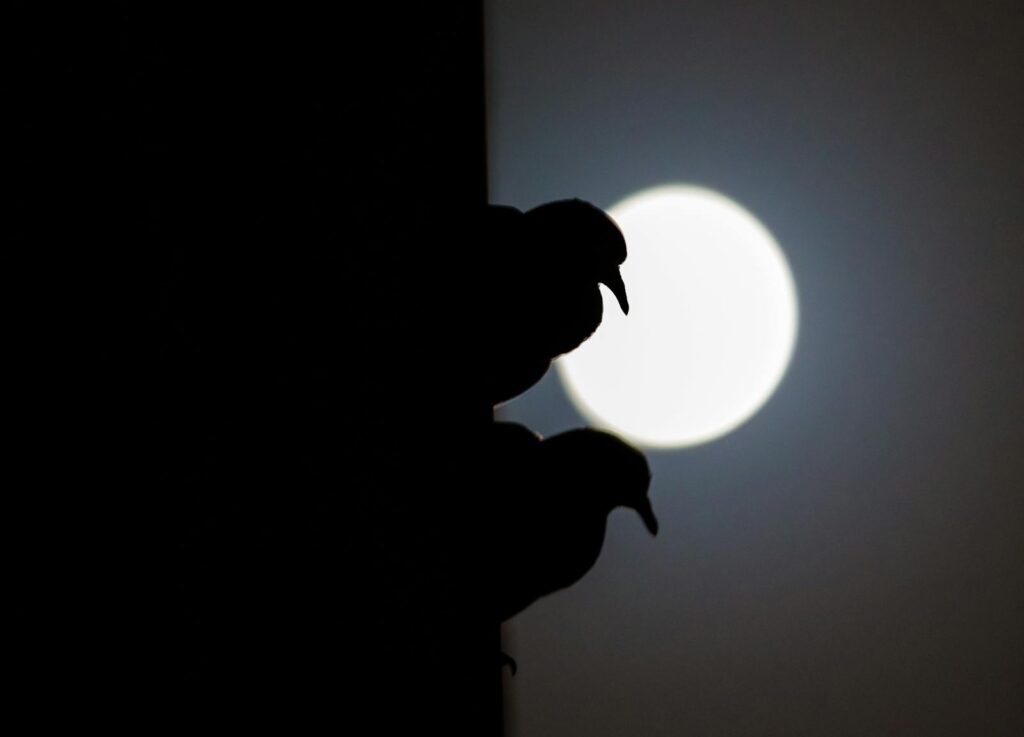
Birds possess sophisticated internal clocks that regulate their daily and seasonal activities, and research suggests these circadian rhythms are partially entrained by lunar cycles. The moon’s predictable patterns provide reliable environmental cues that help birds prepare physiologically for migration, triggering hormonal changes that build fat reserves and increase restlessness as departure times approach. Laboratory studies have demonstrated that exposing migratory birds to artificial lunar light cycles can induce migratory behaviors even when other seasonal cues are absent. For instance, white-throated sparrows kept in controlled environments showed increased nocturnal activity that mirrored their natural migration schedule when exposed to simulated lunar light cycles. This internal lunar responsiveness appears deeply encoded in birds’ genetic makeup, having evolved over millions of years as a reliable method for timing life-critical journeys.
Visual Navigation and Lunar Positioning
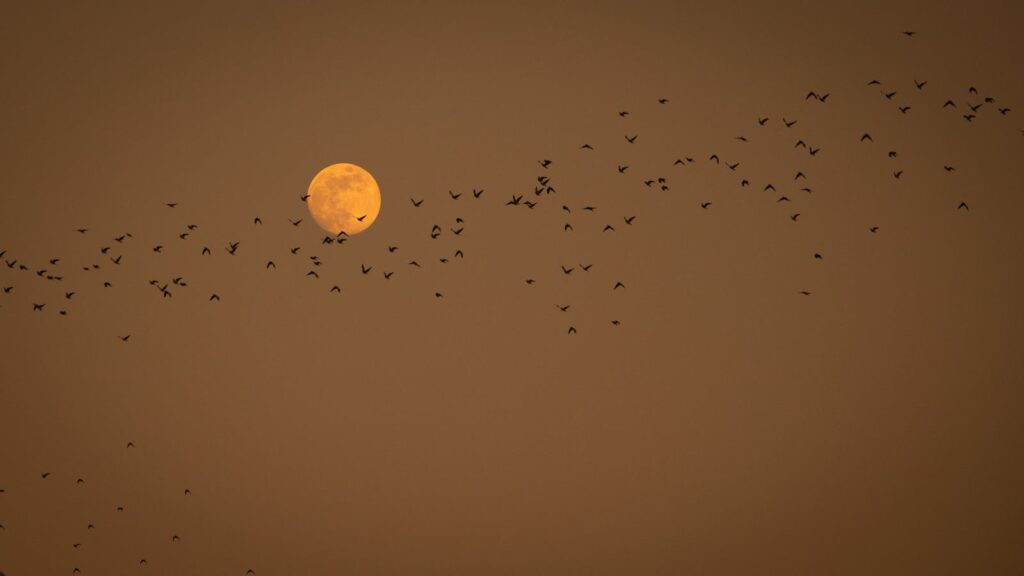
The moon serves as a critical visual reference point that helps migrating birds maintain directional consistency across vast distances. Many species possess specialized neural pathways that process celestial information from both stars and the moon, using these heavenly bodies as a natural compass. Researchers using tracking technology have documented how birds adjust their heading in response to the moon’s position, demonstrating an astronomical awareness that rivals human navigation techniques before modern technology. In controlled experiments, birds exposed to artificial star patterns and moon positions in planetariums demonstrate remarkable ability to orient themselves correctly, even when other navigational cues are eliminated. This celestial navigation system works in concert with birds’ magnetic sensing abilities, creating a multilayered navigation system that remains reliable even when weather conditions degrade visibility of terrain landmarks.
Species-Specific Lunar Migration Strategies
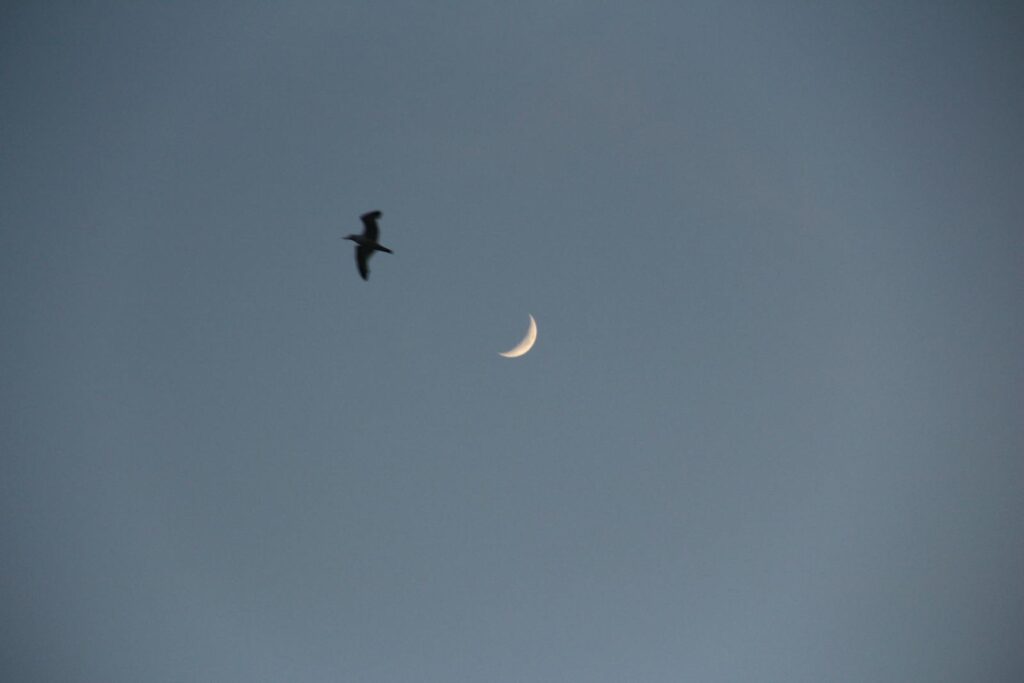
Different bird species have evolved varied relationships with lunar cycles, resulting in diverse migration strategies that optimize each species’ unique ecological niche. Shorebirds like sandpipers and plovers, which frequently travel between hemispheres, show strong preferences for migrating during full moons, when coastal mudflats and feeding grounds are more visible for refueling stops. In contrast, small insectivorous passerines like vireos and flycatchers often migrate during first and last quarter moons, balancing some visibility advantages while avoiding the brightest nights when their own predators have advantages. Waterfowl demonstrate yet another pattern, with radar studies showing ducks and geese often time movements to coincide with the waxing gibbous phase, particularly during autumn migrations when young birds are making their first journeys. These species-specific adaptations highlight how lunar cycles have shaped different evolutionary pathways for birds facing various migration challenges.
Moon Phases and Feeding Opportunities
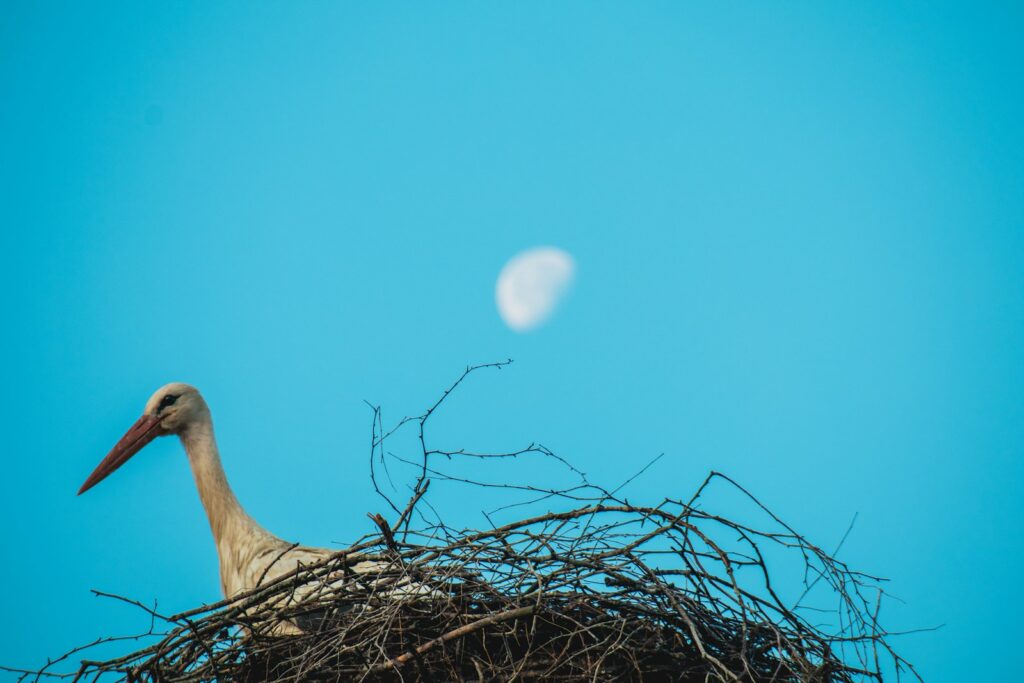
Lunar cycles directly influence food availability along migration routes, creating a biological calendar that birds have evolved to follow. During full moons, many aquatic invertebrates time their reproduction to lunar cycles, creating predictable pulses of food abundance that migratory shorebirds capitalize on during their journeys. Research along the East Asian-Australasian Flyway has documented how great knots and red knots time their arrivals at key stopover sites to coincide with lunar-triggered spawning events of marine worms and mollusks, sometimes flying for days without rest to arrive precisely when food resources peak. Similarly, birds that feed on nocturnal insects find hunting conditions optimized during particular moon phases – quarter moons provide enough light for foraging while maintaining enough darkness for insect activity. These lunar-driven feeding opportunities create a complex network of resource availability that shapes migration timing across entire flyways.
Moonlight and Flocking Behavior
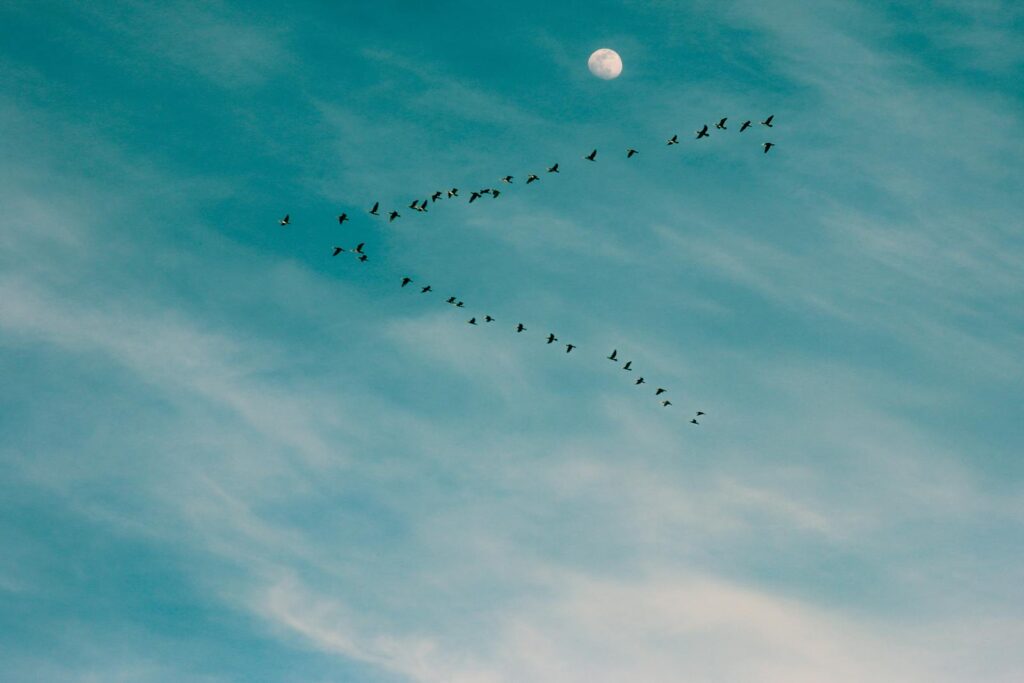
The varying illumination levels throughout the lunar cycle influence how birds organize themselves during migration, particularly affecting flocking behavior and flight formations. During brighter lunar phases, birds often maintain tighter, more coordinated flocks, using the increased visibility to keep visual contact with flock members while reducing the risk of separation. Radar studies have revealed that formation coherence measurably increases during fuller moon phases, with birds maintaining more precise V-formations and line patterns that optimize aerodynamic efficiency. Conversely, during darker lunar periods, many species adopt looser, more dispersed flying arrangements, potentially reducing collision risks when visual coordination is more challenging. These lunar-influenced flocking adjustments demonstrate remarkable behavioral plasticity, as birds constantly adapt their social organization to changing celestial conditions throughout their journeys.
Lunar Cycles and Stopover Decisions
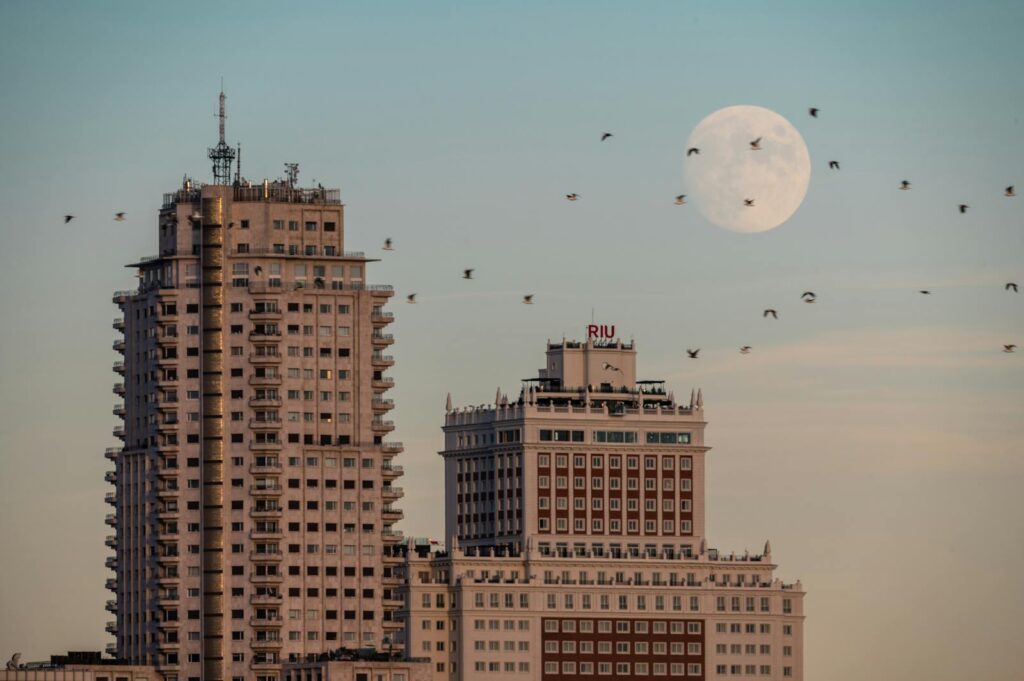
The moon’s phases play a crucial role in birds’ decisions about when to pause their migration at stopover sites and when to resume their journeys. Research using automated radio telemetry has shown that many songbirds time their departures from rest stops to coincide with favorable moon phases, often waiting several days until conditions align with their preferred lunar illumination. For example, studies of Swainson’s thrushes along the Gulf Coast revealed that birds carrying sufficient fat reserves were significantly more likely to depart stopover sites during waxing gibbous and full moon phases, when navigation conditions were optimal. This pattern creates predictable pulses of migration activity that ripple across the landscape in synchrony with lunar cycles. Conservationists now recognize these patterns as critical factors when designing habitat protection strategies, ensuring that key stopover sites remain available during peak lunar-driven migration periods.
Climate Change and Shifting Lunar Relationships
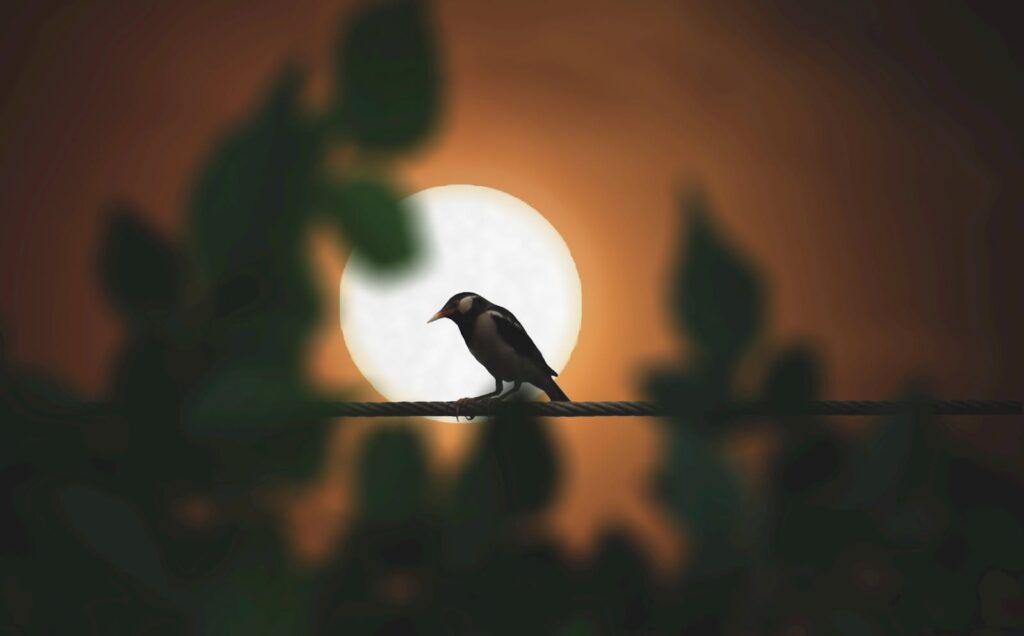
As climate change alters seasonal patterns and weather systems worldwide, the relationship between lunar cycles and bird migration faces unprecedented disruption. Rising temperatures are causing earlier spring plant growth and insect emergence, creating potential mismatches between birds’ lunar-timed migrations and the availability of resources at their destinations. For species that have evolved precise timing between lunar phases and seasonal food availability, these shifts create serious survival challenges. Long-term studies in Europe have documented how some bird populations now arrive at breeding grounds days or even weeks earlier than they did decades ago, yet their lunar navigation systems remain coded to ancestral patterns. This growing disconnect between astronomical cues and ecological conditions represents one of the most concerning aspects of climate change for migratory birds, potentially requiring rapid evolutionary adaptations that may exceed some species’ capabilities.
Conservation Implications of Lunar-Bird Connections
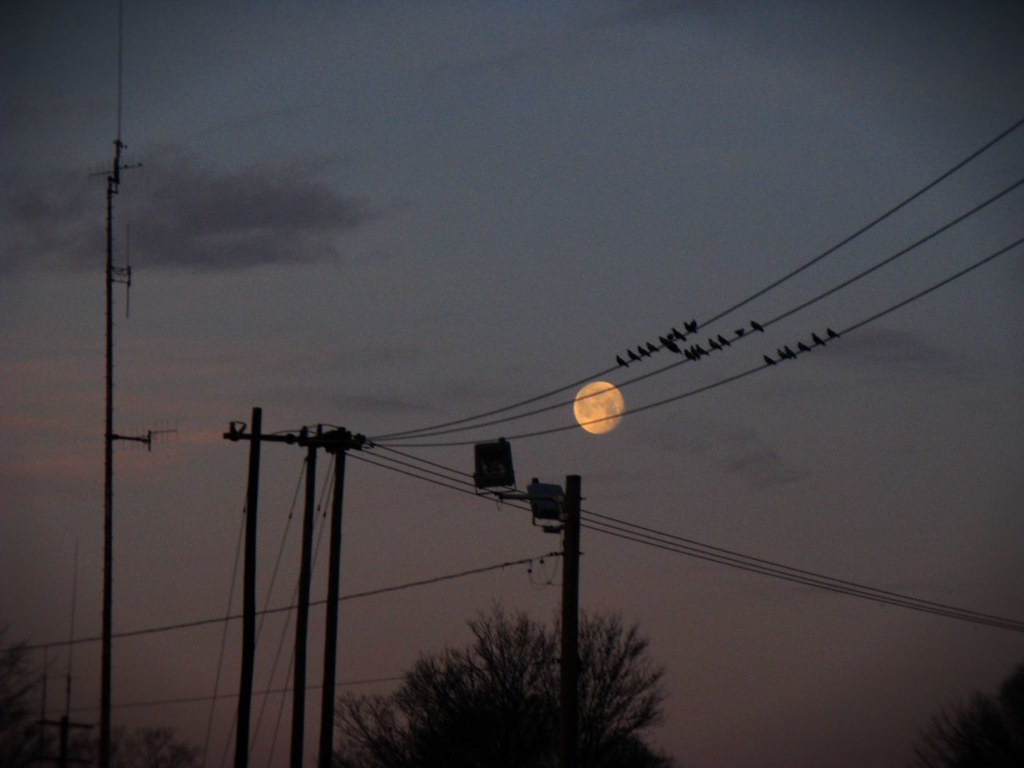
Understanding the relationship between lunar cycles and bird migration has become increasingly important for effective conservation strategies in our rapidly changing world. Conservationists now incorporate lunar calendars when planning habitat protection efforts, ensuring that critical stopover sites receive enhanced protection during key moon phases when bird numbers peak. Light pollution mitigation programs in major cities have begun implementing “lights out” initiatives that coincide with important lunar migration periods, significantly reducing building collisions during crucial movement phases. Weather radar networks originally designed for meteorological forecasting now double as bird migration tracking systems, with their data interpreted against lunar patterns to predict peak movement times requiring special conservation attention. This growing integration of lunar awareness into bird conservation represents an important evolution in wildlife management, acknowledging that protecting migratory species requires understanding both their terrestrial and celestial environments.
The intricate dance between migrating birds and the moon’s phases reveals nature’s remarkable synchronicity. These celestial connections highlight how deeply birds’ evolutionary programming is tied to astronomical cycles that have remained constant for millions of years. As climate change and human development increasingly disrupt these ancient patterns, understanding the relationship between lunar phases and bird migration becomes not merely an academic curiosity but critical knowledge for conservation. By recognizing how the moon guides these remarkable seasonal journeys, we gain both appreciation for birds’ navigational prowess and important insights for protecting these aerial travelers. Our feathered neighbors, silhouetted against the moon during their epic migrations, remind us that Earth’s wildlife exists within a broader cosmic context—one where the gentle pull and glow of our nearest celestial neighbor continues to influence life’s rhythms across our planet.
